
Article written and contributed by Karen Clift
Umbrella Man (UM) and his role, if any, in the assassination of President Kennedy has been a source of debate among assassination researchers for many years. Some believe he really was the heckler, Steven Witt, who testified before the HSCA. Many others believe him to be a signalman of some sort. Still others contend he was a shooter, using a secret James Bondian weapon to fire a poison dart.
The notion that UM was a shooter was put forward by Richard Sprague and Robert Cutler in Gallery magazine and other publications in the 1970s. Despite the fact that such a weapon was known to exist and be in the hands of the CIA in 1963, and was thought by Fletcher Prouty to have been used in Dealey Plaza, this theory has received possibly the least support from researchers. Indeed, it is quite fantastical. But, then again, is there any aspect of the assassination that is not fantastical?
I was intrigued by the possibility of a poison dart being fired from an umbrella but, like many others, was not 100% convinced. That is, not until I found what I perceived to be alterations in two of the most famous photos from that fateful day. While studying these modifications and trying to determine why they would have been made, I came to the conclusion that UM must have been a shooter.
Let me walk you through my voyage of discovery and then I will elaborate on the conclusions I reached as a result of those discoveries. Let’s begin with the key anomaly that led me to believe the photos were modified.
In 1963, the Stemmons Freeway sign had two small signs attached to its left leg:
- A rectangular sign on top saying NORTH
- A badge-shaped sign below saying TEXAS U.S. 77
The signs were definitely attached to the leg on November 22, 1963.
Upon looking at an enlarged version of the Willis 5 photo, it appeared to me that those signs weren’t there. I couldn’t see any evidence of the solid white backgrounds or the black lettering. Instead there were artifacts, as if some pixels were removed and some were left behind. It made for an odd appearance; the area did not look exactly like the signs nor did it look exactly like the grassy area behind, but more like a strange hybrid of the two. I could also discern the gap between the signs, but the edges were soft and fuzzy, not the hard edges I would expect to see from metal signs.
In addition, I saw no firm evidence of the left leg of the Stemmons sign. The white vertical line that gives the illusion of being the left leg is actually the antenna of a DPD motorcycle. Notice how it extends above the bottom of the sign and is also too far to the left. The real leg would be below the “K” in “KEEP.”
In considering what reason there might be for parts of the signs to be absent and other parts partially erased, it seemed logical that something must have been in front of the sign originally, partially blocking the view of these items, and that object had subsequently been moved or deleted. The portions of the signs that were unobstructed would now stand out and would need to be toned down in some manner.
Phil Willis said he snapped his picture when he was startled by the sound of the first shot. Charles Bronson said he snapped his picture for the same reason, at the sound of the first shot. So the Willis and Bronson photos should have been taken at nearly the same instant. I compared the two pictures to see if there were any differences that might account for an object being moved or deleted.
The first thing that came to mind was Umbrella Man. In Bronson’s photo, UM is standing in front of Stemmons with a raised umbrella. Zapruder also shows UM in front of Stemmons with a raised umbrella as the limo passes the sign. But in Willis, the umbrella is lowered and UM appears to be behind the sign. Could this be the object that was removed from in front of the sign?
There are other possible anomalies in this photo that I will discuss later, but for now I’d like to point out just one more thing. In the Willis photo there is a piece of the umbrella on the right side (as we look at it) that is darker than the rest. It looks as if it has been added to the photo.
Finding some questionable elements in the Willis picture, the next step was to examine Hugh Betzner’s photo, which was taken just a few moments earlier from a similar position.
Betzner 3 also appears to be missing the left leg of the Stemmons sign as well as the two small signs attached to it. Once again, I saw no discernible edges on the signs, no solid white backgrounds and no black lettering, except for the number “77” on the bottom sign. According to my measurements, the word “NORTH” on the upper sign is two-thirds of the height of “77.” If I could see “77” so distinctly, why couldn’t I see any portion of the word “NORTH”?
Just as with the Willis photo, I saw what I perceived to be artifacts, as if some pixels were removed and some were left behind. Although we don’t see UM at all and only part of his umbrella, it appears as if he is behind the sign with umbrella lowered. And just as with Willis, the right corner of his umbrella is darker than the rest of it and looks as if it has been added to the picture.
So far, the modifications I perceived were consistent between the two pictures, but there are other aspects that are inconsistent between them. Further investigation is needed to determine if these are due to purposeful modifications, or merely to different lenses and camera angles.
- In W5, there are three people grouped together under the sign and the brunette is the tallest. In B3, the blond is taller and they also seem to be farther away.
- In W5, there is one woman standing in front of the right leg of the Stemmons sign. In B3, she is a few feet behind the leg and a different woman is in front of the leg.
- In W5, the Stemmons sign is straight. In B3, it is slanted even though Zapruder’s pedestal is roughly horizontal in both.
- In W5, the black margin above “STEMMONS” appears to be missing, although this could be due to the extreme blurriness of the lettering.
As for how the pictures got this way, if they were in fact modified, Betzner gave his camera to local authorities on the day of the assassination before the film was developed. He received the camera and the negatives that same afternoon, but did not receive any prints made from the negatives. While still being interviewed by authorities, the FBI asked to borrow his negatives and Betzner took them to the FBI office the following morning. He received them back several days later.
Willis took his film to a local Kodak lab and waited for it to be processed. In an interview with author Richard Trask, Willis stated that he only viewed his slides twice before loaning them to the Secret Service on November 25, 1963. He received his slides back from the Secret Service in January 1964.
SUMMARY SO FAR
I believe the two photos were altered. I simply do not see any evidence of the small signs being intact, solid objects. It appears to me that, in the Willis photo at least, UM was in front of Stemmons with a raised umbrella, but was subsequently moved to appear behind the sign with a lowered umbrella. As a result, the portions of the two small signs that he was not obstructing had to be toned down so as not to stand out. I think it is likely that other bystanders were relocated to help conceal the missing elements.
The Stemmons sign in the Willis photo may also have needed alteration once the umbrella was removed from in front of it. Researchers have previously pointed out that the sign appears too straight, overly blurry, and too cropped at the top.
I believe the Betzner photo was modified in such a manner as to be consistent with Willis. It doesn’t appear that UM was blocking as much of the signs as he was in Willis, but they were erased anyway in order to match the other photo. I also think it is quite likely that the man in the extreme foreground was moved to the right to cover UM completely. His placement is incredibly convenient, and it almost looks like the floating “77” in the background is on top of his sleeve in the foreground. Furthermore, it looks like someone’s head is behind the sevens. That is impossible when the sign has an opaque background.
Now for the more difficult question: why would UM have been moved?
HYPOTHESIS
Assuming that my observations are correct and these photos were altered, wouldn’t that be a bit risky? The Zapruder film is generally considered to be modified, but it took expert analysis and mathematical equations to demonstrate it. With these photos, just looking at them closely drew my suspicion.
Furthermore, if the concern was only about UM being seen with a raised umbrella, why not just lower it and leave him where he was? It was much more work for the editors to move him to the side, erase portions of the signs, and possibly relocate other bystanders.
So why did the editors go to so much effort and risk to hide UM? I believe the answer lies in that corner piece of the umbrella that had to be added to both pictures.
If we can trust the Z-film on this point, the side of the umbrella with the added patch would have been in front of the Stemmons sign. In both photos, there is nothing that obstructs our view of the sign. Therefore, there shouldn’t have been anything blocking that side of the umbrella either. Yet, in both shots, it looks as if a patch has been created and placed on the same part of the umbrella. Why?
Even though people have balked, and even outright laughed, at the idea of this umbrella being a flechette-launching model, I think we must give it serious consideration. It’s entirely possible that the patch is there to hide part of a firing mechanism, or to replace a piece of the surface that was removed to accommodate the mechanism.
To add further weight to this hypothesis, in November 2013 one of the Parkland nurses came forward for the first time about something she saw in the ER on the day of the assassination. Phyllis Hall, the very first nurse to enter Trauma Room 1, said that while she was cradling the president’s head, she saw a bullet in JFK’s neck.
“I could see a bullet lodged between his ear and his shoulder,” she said. “It was pointed at its tip and showed no signs of damage. There was no blunting of the bullet or scarring around the shell from where it had been fired.”
“I’d had a great deal of experience working with gunshot wounds, but I had never seen anything like this before. It was about one-and-a-half inches long – nothing like the bullets that were later produced. It was taken away but never have I seen it presented in evidence or heard what happened to it. It remains a mystery.”
Phyllis’s description of the bullet sounds very much like a flechette, and JFK did apparently have a neck wound in that location. In 1989, Tom Wilson, an electrical engineer and photonics expert, used special photo analysis equipment to examine the autopsy photos in 3D. He determined that the small defect in the neck was an actual wound. (To lend credence to this assessment, Tom’s non-JFK photo analysis work has been admitted as evidence in several court cases.)
Researchers have long suspected that JFK was paralyzed in some way due to his lack of movement and lack of speech, especially when compared to the extensive movements and vocalizations of Gov. Connally.
CONCLUSIONS
Based on my opinion that the Willis and Betzner photos have been altered, and that the reason for doing so was to hide the actions of Umbrella Man, I have come to the following conclusions.
First and foremost, UM was not a heckler. I cannot conceive of any possible reason for conspirators to go to the effort and the risk of modifying pictures merely to keep the American public from seeing Mr. Witt standing on the sidewalk with a raised umbrella.
Second, I do not believe UM was a signal man, or at least not exclusively. The people who planned the assassination were, presumably, experienced at being discreet during a covert operation. Dark Complected Man’s signal was fairly discreet. Although he reportedly stepped into the street and was waving vigorously, waving at the president is not unusual. Jean Hill said that she, too, stepped off the curb and waved excitedly at JFK in order to draw his attention for her friend’s picture.
UM’s actions were much more conspicuous. The late Rich DellaRosa gave this oral account of what he saw in an “other” (yet to be identified) film of the assassination:
”Just about the time that (the limo) got to the point where the gunshots occurred, there was a lot of activity on the right-hand side on the curb. The first thing you noticed was the guy that we call the Umbrella Man was furiously pumping the umbrella up and down. He wasn’t just holding an open umbrella as we’ve been (told) by a number of other researchers. He was pumping the umbrella up and down – there was a lot of movement.”
I submit that these were not the actions of someone trying to send a clandestine signal. Doubtless, everyone in the vicinity saw what he was doing, and that may be why the theory persists to this day that he was a signalman.
In reality, given UM’s location on the street, it’s doubtful he could have been seen by all the rifle teams. I believe the Dal-Tex location would have been blocked by the TSBD. Anyone behind the picket fence would have been hampered by the fence, the trees, the difference in elevation, and possibly the Stemmons sign itself. And then, of course, there’s the shooter in the storm drain.
If UM was a signaler, realistically he could have only been signaling to someone in the motorcade, and I’m not sure who else would have mattered other than the driver. If the umbrella pumps were a signal, then it was most likely to tell the driver to slow down so that UM could take his shot.
Unless I am overlooking another possibility, I think UM had to be a shooter. The most plausible scenario, in my opinion, is that he fired a flechette or dart containing a paralytic poison into the president’s neck as his limo approached the Stemmons Freeway sign.
DCM then signaled to Greer, the driver of the limo, to stop the car so the turkey-shoot could commence. In DellaRosa’s account, he said that as soon as Greer saw DCM’s closed fist, he stopped the car instantly. The fact that the car stop occurred immediately after UM performed his function makes me think the two actions were related. Otherwise, Greer could have simply been told ahead of time “When you get to the Stemmons sign, about halfway down Elm, stop the car.” Why did he need a stranger on the street to tell him when and where to stop?
RISKS – IN DETAIL
As I mentioned earlier, UM’s actions and the subsequent cover-up of those actions were potentially risky to the conspirators. His role, therefore, must have been suitably important to warrant those risks. Let’s examine some of them in detail:
- Drawing attention to himself, he opened a large umbrella on a sunny day. He drew further attention by pumping it several times, raising it high above his head, and twirling it.
- In addition to being seen by eyewitnesses, these actions were caught on film and in photos, which I believe were subsequently collected and edited to conceal his actions. (What would have happened if they had missed some?) They apparently did miss one picture (Bronson), which gave us visual confirmation of UM holding a raised umbrella.
- Assuming that there are edits in the Willis and Betzner pictures, they were at higher risk of being discovered. Unlike the Zapruder film, which required special knowledge and/or special equipment to detect its alterations, a layperson could perceive modifications in these two pictures. Even if someone was unfamiliar with the Stemmons sign, just comparing the pictures to each other would show differences that could draw suspicion.
- If it could be proved that the photos were indeed edited, and since those edits could not have been performed by Oswald, one could reasonably conclude there was a conspiracy (UM) and a cover-up (edits).
Consequently, the mission carried out by UM must have been so crucial to the operation as to be worth those risks, including potential exposure of the conspiracy and its cover-up. What could have been worth all of that?
Unless I’m overlooking a more compelling option, I think it would have to be the paralyzing of JFK. He simply could not be allowed to duck out of the way of the coming onslaught. Therefore, I believe they were willing to do whatever it took to fire the flechette, no matter how conspicuous, and to cover their tracks afterward, no matter how risky. It may have been the lynchpin to the entire assassination plot.
RED HERRINGS
Assuming all of the foregoing is correct, the conspirators would have realized the risk they were facing from the altered photos of Willis and Betzner. I believe the conspirators employed a few tactics to minimize that risk.
It is my contention that, at the time of editing, a mysterious element was added to the photos to divert attention away from UM and the alterations. Black Dog Man (BDM) only conclusively appears in these two photos. And the shape appears to be a 2-dimensional nondescript blob that lacks depth, shading, and texture – in other words, an artificial element that was added to the picture. He also appears to be a different size in each photo when other objects (people, Stemmons sign, and concrete wall) are essentially the same size in each picture.
The hypothesis that BDM was added as a diversion is further aided by the fact that when Life magazine first published these photos in 1967, they went to great lengths to point out the figure to their readers. They confirmed that Itek verified it as a man, explained why he didn’t appear in other pictures (which was a clever touch), and reassured us that he was most likely just an onlooker. Nearly 40% of the narrative on the page was focused on BDM. Why would there be so much print about one innocent onlooker if he wasn’t a diversionary tactic? (There was not one word about UM.)
Twelve years after the publication in Life, the conspirators apparently were still concerned about UM being found out so they went to the unprecedented lengths of fabricating the Steven Witt character and having him put on a theatrical performance for the HSCA to help dispel the growing mystery around UM.
Umbrella Man was taken completely out of public discussion in late 2011 when the New York Times, Errol Morris, and Josiah Thompson created a “documentary” puff-piece claiming that Witt’s story was just so crazy that it must be true. That was all the “evidence” Mainstream Media needed to close the books on UM for good.
EPILOG
As I’ve said throughout this article, I believe the Willis and Betzner photos were altered, and done so for the express purpose of concealing the activities of Umbrella Man. But even if the photos turn out to be 100% genuine, I feel there is still enough circumstantial evidence to make a case for UM being a shooter.
He was not a heckler. Mr. Witt’s description of his activities for the HSCA did not match UM’s reported actions in Dealey Plaza. Furthermore, the umbrella Witt produced was not the same as the one used by UM.
UM was not a signalman, at least not exclusively. All parties in the Plaza couldn’t see him and his choice of signal was bizarre and highly conspicuous. If anything, he may have signaled the driver to slow down for the flechette shot.
To me, the most likely event is that UM was a shooter. The flechette-launching umbrella did exist, and the CIA reportedly had dozens of them. Fletcher Prouty also believed it was used in Dealey Plaza that day. The umbrella was only opened when the limo approached, and was closed again immediately afterward.
The action of pumping it in the air multiple times was quite unnatural and, if not a signal, may have been needed in order to prepare the weapon for firing.
A projectile matching the description of a flechette was found in JFK’s neck in the Parkland ER and disappeared thereafter, never appearing in evidence at any hearing.
The actions of JFK during the assassination sequence have always been suspect. He apparently did not speak, nor did he make any effort to remove himself or his wife from the line of fire. This seems particularly strange for a man who had been in combat and undoubtedly knew the sound of gunfire and how to avoid it. I can only conclude that he was physically unable to take any protective actions. The paralytic poison used in flechettes was said to immobilize a target within two seconds.
In conclusion, my reasons for presenting this lengthy dissertation were:
- To bring the potential photo alterations to light for further study and examination
- To refute the allegations that UM was a heckler – I firmly believe he was part of the conspiracy
- To give credence to the theory of UM being a shooter
- To cast (additional) doubt on the existence of BDM
- To invite other well-reasoned interpretations of the events described herein
And lastly, I would like to encourage new investigation not only into these photos, but all others that seem suspect. Not just a rehashing of the same theories, but looking at photos and film with a fresh perspective. There may still be many things to find within them.
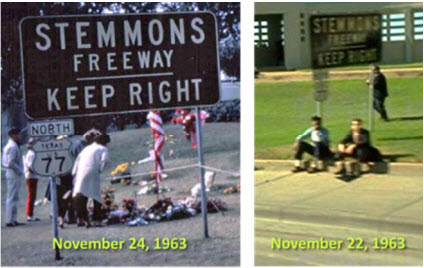
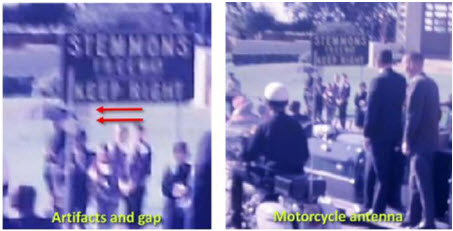
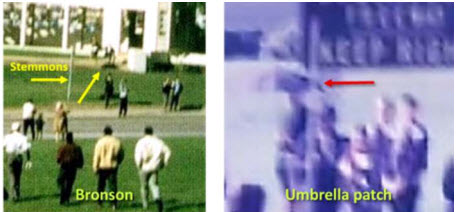
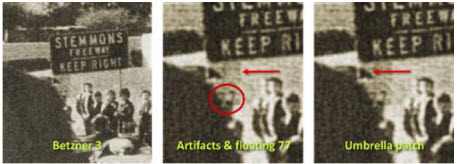

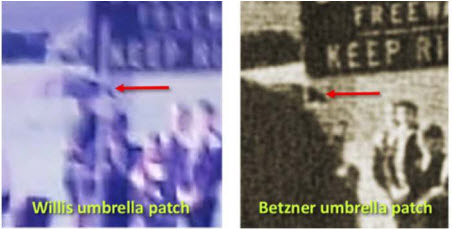


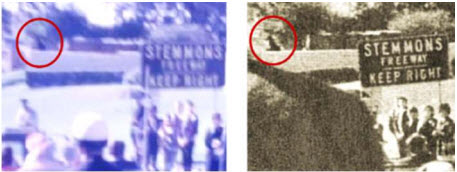
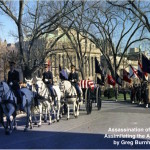
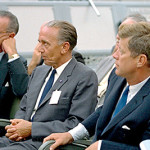
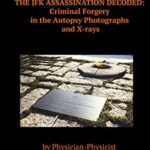
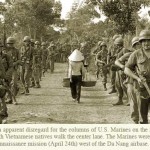
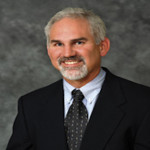
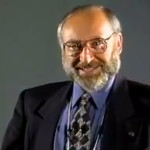
Interesting article indeed, Karen. If UM was a shooter (with a flechette to perhaps paralyze JFK) one wonders what the purpose would be, since (I assume) that shot came well after the throat wound and the back wound. If those two shots came before an alleged flechette then I would think he was already paralyzed having been hit with two shots. But maybe the “shooting teams” didnt act in cohort and were just firing away in no special sequence. I suppose anything is possible – or the flechette is just another Black Dog Man or Badgeman; pure disinfo, if you know what I mean? 🙂
Congratulations, Karen, research exceptionally very well done. An important analysis imo…as has been mentioned, research into all previous thought to be concluded, can and possibly will expose new information and developments not perused previously may come to light, the old adage of ”never stop reviewing” within the research ,comes to mind..in particular the witnesses information and statements, .please carry on. And the very best to you and your work in the future, Go get’em Girl…..the very best b..
Thanks so much Bernice! Much appreciated!
The following may be of interest to those who seem to continually guffaw at the idea of their CIA having such as the flechette weapons…fwiw thanks b
“Top Secret: How To Kill–The CIA’s Secret Weapons Systems”, by Andrew Stark
unless we know MUCH MORE about the atrocities committed “in the interests and name of `national security,'” how can we possibly become sufficiently motivated and driven to dedicate our energies towards changing this form of “government” by lies, dissembling, expediency, profit-as-god, and murder? we have no idea what is “done in our name.” if we did, we would no longer be able to participate in its commoditized seductiveness because we would not be able to look ourselves in the mirror or sleep at night.
–ratitor
http://www.ratical.org/ratville/JFK/CIASWS.html
More of what does not exist to some that is…like hellooooooooo.
the photos of the following are within..the site, sorry right now I have not got the separate page…very interesting..thanks b
1.08 INCH PUSH ROD FLECHETTE
1.08 INCH STING RAY FLECHETTE
1.1 INCH COATED BEE HIVE FLECHETTE
1.2 INCH COATED FLEX FLECHETTE
http://www.bombsecurity.com/CABO/caboweap3.html
Within this thread from the Education Forum, there are links I have posted to articles and information re tum and dcm…fwtaw..fyi…if interested as well as many other interesting posts from the membership…thanks b
http://educationforum.ipbhost.com/index.php?showtopic=18413&hl=+posted +bernice +moore
Sorry I missed the title of the thread for your information, it is…
Josiah Thompson & the Umbrella man
http://educationforum.ipbhost.com/index.php?showtopic=18413&hl=+posted
An side research note..re the limo stopping…even Witt in his testimony testified to the same..occurring thanks b
Nov 27, 2011
Mr. WITT. No. I continued to move forward and finally got this umbrella up in the air. I think by the time I got the thing up in the air I was over and possibly standing on the retaining wall.
Mr. GENZMAN. Did President Kennedy see your umbrella?
Mr. WITT. I have no way of knowing. I really don’t.
Mr. GENZMAN. What do you next recall happening?
Mr. WITT. Let me go back a minute. As I was moving forward I apparently had this umbrella in front of me for some few steps. Whereas other people I understand saw the President shot and his movements; I did not see this because of this thing in front of me, The next thing I saw after I saw the car coming down the street, down the hill to my left, the car was just about at a position like this [indicating] at this angle here. At this time there was the car stopping, the screeching of tires, the jamming on of brakes, motorcycle patrolman right there beside one of the cars. One car ran upon the President’s car and a man jumped off and jumped on the back. These were the scenes that unfolded as I reached the point to where I was seeing things…..
http://jfkassassination.net/russ/jfkinfo2/jfk4/witt.htm
Witt’s testimony b
a comment by Jack White posted on march 6th 2008….on the EF about alterations within the photographs, which imo is common sense, nothing dramatic , nothing over the top, such as some like to express re his research within such, being that he surmised all the photos had been altered…their words , not his…
He may well have posted further comments again later on, but for now this is to me the clearest of his feelings that I have come across…thanks Jack for your brave , and courageous stance and taking imo all the b/s crap you took from those imo who cannot see …..and or have their pet theories so written in stone, to the point that any new research and or alterations might affect theirs is prohibited. Lord forbid…they are ”the absolutists..” who will not and do not accept nor tolerate the differing points of view seen by most to be essential for the health of the research world….imo b..
Today at 11:52 AM
Yes. But most of them are NOT SIGNIFICANT. I only talk about those that
were altered. Many of the photos show nothing of significance.
I used to think that Moorman and Altgens 6 were genuine, but now believe
otherwise. Parts of many films are genuine, with only partial alterations.
I used to think Wiegman was genuine, but now think parts may altered.
Those images that were published IMMEDIATELY have the best chance
of not being altered. Remember, there was an FBI dragnet which obtained
ALL FILMS except “Zapruder” and kept them for long periods of time. The
only images published quickly were Moorman (cropped) and Altgens 6
(highly retouched).
The proof of alteration is within the images or comparison with other
images.
Jack
http://educationforum.ipbhost.com/index.php?showtopic=12406
Greg,
I agree 1000 % with you here regarding “TUM”…excellent analysis…
TUM as a “shooter” was also mentioned and written about in
“Taking of America 1-2-3” by Richard E. Sprague and was discussed
during/in the Sen. Church Hearings of the 1970’s…I met and spoke with RB Cutler many times…& after coming across a book how this type of “device” was not just created & used by CIA/Pentagon sources.The KGB and Eastern European Intelligence Services also had, as a part of their “bag of tricks” a similar “device” and was even the topic and source of several news stories in the late 1970’s and early 1980’s on US news outlets when USSR and their Iron Curtain counter-parts used it to silence/murder/poison opponents and dissidents is what “sealed” it for me. . It was and is no surprise to me that no one in the US media had the brains to recognize and voice such a “potential recognition” of such a “device” actually captured on film and photographs just as JFK is being assassinated!!! NOT A COINCIDENCE….I agree with you completely !!!
regards…
from : david t. krall
email: truthatlarge@hotmail.com
I’m certainly not an expert by any means, but Umbrella Man looks like Roy Hargraves. Please look at the image at 4:59 of the youtube vid: https://www.youtube.com/watch?v=sJKYloRjKZs
Then compare to Hargraves photo shown here at the following link:
http://beforeitsnews.com/alternative/2013/10/incredible-links-between-the-murders-of-jfk-olof-palme-and-john-lennon-2789184.html?currentSplittedPage=2
Yes, but Roy Hargraves also “looked like” any number of men in any city in the world. That really doesn’t narrow it down at all. Debating who it was is no longer relevant because they not only got away with it but they are most likely already deceased by now, as well.
I believe this to be true: The Umbrella Man’s task was to signal for the limo to stop – actually to be seen as soon as Greer turned into Elm Street. I believe Greer was told in advance that there was a point where he had to stop the vehicle, and the UM (and DCM) was the point where Greer would look for the yellow markings to his left. Consequently, if UM/DCM’s tasks were to stop the limo, then Abraham Zapruder never went home to get his camera and the Z film was a pre planned event.
Well written, Greg, thanks for sharing. You certainly have made a strong case here.
The weaponry system was already operational in 1963, and as you have pointed out between the president’s inability to duck for cover added to the observations of Nurse Hall (someone highly skilled & experienced with gunshot wounds) not being familiar with the “bullet” she saw, UM is/was clearly much more than a simple heckler.
Thank you Alan. The article was actually written by Karen Clift. I am merely the publisher. While I don’t necessarily agree with 100% of her conclusions, I do feel it was well researched and well written. IMO: A reasonable person must remain open minded as to what the presence of these anomalous persons–in such close proximity to the event–means. Their presence certainly does not appear to be innocuous nor does their behavior.
couldn’t umbrella man been there using his umbrella to gauge wind for the lethal shot?
THIS BOOK SHOULD BE IN EVERY HOME & CLASSROOM
Wilful Blindness: Why We Ignore the Obvious
by Margaret Heffernan (Author)
In the 2006 case of the US Government vs Enron, the presiding judge instructed the jurors to take account of the concept of wilful blindness as they reached their verdict about whether the chief executives of the disgraced energy corporation were guilty. It was not enough for the defendants to say that they did not know what was going on; that they had not seen anything. If they failed to observe the corruption which was unfolding before their very eyes, not knowing was no defence. The guilty verdict sent shivers down the spine of the corporate world. In this book, distinguished business woman and writer, Margaret Heffernan, examines the phenomenon of wilful blindness. Drawing on a wide array of sources from psychological studies and social statistics to interviews with the relevant protagonists she examines what it is about human nature which makes us so prone to wilful blindness. Taught from infancy to obey authority, and absorbing the importance of selective vision as a key social skill, humans exacerbate their tendency to become institutionalised by joining organisations which are run by like-minded people. She looks at how hard work and the information overload of the modern workplace add to the problem. And she examines why whistleblowers and Cassandras are so very rare. Ranging freely through history and from business to science, government to the family, this engaging and anecdotal book will explain why wilful blindness is so dangerous in the globalised, interconnected world in which we live, before suggesting ways in which institutions and individuals can start to combat it. In the tradition of Malcolm Gladwell and Nassim Nicholas Taleb, Margaret Heffernan’s thought provoking book will force open our eyes.
Review
‘Willful Blindness is an engaging read, packed with cautionary tales ripped from today’s headlines as well as a trove of research on why we often stick our head in the sand. With deft prose and page after page of keen insights, Heffernan shows why we close our eyes to facts that threaten our families, our livelihood, and our self-image — and, even better, she points the way out of the darkness’ Daniel H. Pink, author of DRIVE and A WHOLE NEW MIND ‘A thoughtful and entertaining treatise on the seductiveness–and consequences–of ignoring what’s right in front of our eyes, from former CEO and author Heffernan (The Naked Truth). We frequently ignore painful or frightening truths, subconsciously believing that denial can protect us, she argues, but our delusions make us ever more vulnerable, and whatever suffering we choose to ignore continues unabated. The author draws examples from the private–Bernie Madoff’s family’s blindness to his Ponzi scheme; a woman who married an alcoholic; another unable to see that her husband is sexually abusing her daughter–to the public: Alan Greenspan ignoring the housing bubble, a soldier working for Hitler. She gives us an insightful look into the psychology of denial and makes an ethical and pragmatic argument for engagement rather than deflection. Heffernan’s cogent, riveting look at how we behave at our worst encourages us to strive for our best’ US Publishers’ Weekly ‘We can all be guilty of denying the truth and reluctance to acknowledge uncomfortable facts is all around but just what makes us so inclined to wilful blindness? Heffernan addresses this using psychological studies and interviews and applies her theory to explain why incidents such as the financial crisis occur’ Daily Express 25/2 ‘Writing in clear, flowing prose, (Heffernan) draws on psychological and neurological studies and interviews with executives, whistleblowers and white-collar criminals…the book made me think long and hard about how the pace and priorities of our daily lives can hinder our ability to live as decently and as truthfully as we can’ Nancy F. Koehn, New York Times April 2011 ‘Willful Blindness is a remarkable book…It is a tour de force of brilliant insights, broad span applications and written in the most engaging style.’ Philip Zimbardo ‘Uniquely broad in scope, insightfully analyzed, and engagingly written. This in-depth look at willful blindness is an excellent read.’ Albert Bandura –This text refers to an out of print or unavailable edition of this title.
About the Author
MARGARET HEFFERNAN was born in Texas, raised in Holland and educated at Cambridge University. She worked in BBC Radio as a television producer, before leaving to run the trade association IPPA. She returned to the US where she worked on public affair campaigns and with software companies trying to break into multimedia. She then joined CMGI where she ran, bought and sold leading Internet businesses. She is a visiting professor and Entrepreneur in Residence at the University of Bath. She is the author of The Naked Truth and How She Does It, and Wilful Blindness. She writes a regular column for Real Business and the Huffington Post.
JFK wore a back brace. This would have limited his ability to bend over and crouch out of the way.
Not true. After the final shot he is seen laying on his wife’s lap! The brace did not hold him up.
Sorry, but your analysis of the UM is faulty. Most of the visual evidence you point out involves a motorcycle that is passing through the scene(s). The motorcycle’s windscreen and rear radio antenna whip account for the anomalies in your analysis.